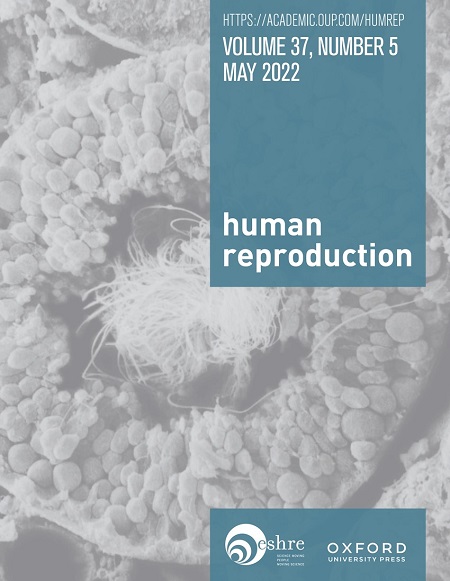Hematologic cancers in women: from fertility preservation to post-cancer fertility outcomes.
IF 6
1区 医学
Q1 OBSTETRICS & GYNECOLOGY
引用次数: 0
Abstract
STUDY QUESTION How do hematological characteristics affect ovarian reserve, ovarian response to ovarian stimulation, and fertility outcomes? SUMMARY ANSWER Although lymphoma characteristics impact serum AMH levels, they do not affect, per se, the response to ovarian stimulation and the number of mature oocytes recovered at the time of fertility preservation; in addition, fertility in survivors of hematologic malignancies is relatively conserved. WHAT IS KNOWN ALREADY Hematologic cancers can affect young women of reproductive age. While survival rates have improved over the years due to advances in treatment protocols, the treatments used can impact fertility. Fertility preservation methods, such as oocyte or ovarian tissue cryopreservation, are increasingly offered, but concerns remain about reduced ovarian reserve and response to ovarian stimulation in women with these cancers, which may influence the effectiveness of fertility preservation strategies. Moreover, fertility potential after hematologic cancers has been poorly studied. STUDY DESIGN, SIZE, DURATION This is a retrospective, observational bi-centric cohort study. All patients with hematologic cancer (lymphoma, leukemia, myeloma, and myelodysplastic syndrome) who underwent fertility preservation before gonadotoxic treatment (n = 286) from January 2013 to March 2023 were included. For fertility after cancer, and use of frozen oocytes/embryos, the endpoint date was 7 July 2023. PARTICIPANTS/MATERIALS, SETTING, METHODS Only patients with lymphoma were included for analysis of ovarian reserve (n = 238) and ovarian response to ovarian stimulation (n = 230). Low ovarian reserve and impaired ovarian response to ovarian stimulation were defined as AMH <1.2 ng/ml and ≤9 mature oocytes retrieved after ovarian stimulation, respectively, according to POSEIDON criteria. A Cox regression model was used to determine predictive factors of impaired response to ovarian stimulation, low ovarian reserve, and pregnancy after cancer. Cumulative incidence of pregnancy and cumulative use of frozen oocytes/embryos was calculated in all patients suffering from hematological malignancies. MAIN RESULTS AND THE ROLE OF CHANCE There was an impact of lymphoma characteristics on AMH levels independent of age. After adjustment based on POSEIDON Groups 3 and 4, no specific impact of lymphoma characteristics (e.g. stage, clinical, or biologic B signs) on ovarian response to ovarian stimulation was observed. Regarding post-cancer fertility in the whole population, among the women who tried to conceive, 62% achieved at least one pregnancy, and 85% of these occurred naturally. After adjustment, positive predictive factors for pregnancy were age <35 years, being in a relationship at the first oncofertility consultation, and absence of hematopoietic stem cell transplantation. LIMITATIONS, REASONS FOR CAUTION Limitations include potential biases due to the heterogeneity of hematological conditions and the retrospective design, which may lead to missing data. Additionally, the duration of follow-up may not be sufficient to evaluate long-term fertility outcomes. WIDER IMPLICATIONS OF THE FINDINGS Lymphoma characteristics did not affect the response to ovarian stimulation in terms of mature oocyte retrieval, although AMH levels were impaired. Reassuring post-cancer fertility data support informed decision-making regarding fertility preservation techniques. Larger prospective studies are needed to tailor oncofertility counseling, ensuring optimized care and reproductive outcomes. STUDY FUNDING/COMPETING INTEREST(S) Medical editorial support was provided by Peter Todd of Tajut Ltd (Kaiapoi, New Zealand) and was funded by AFPR (Advances in Fertility Preservation and Reproduction). The authors declare no conflicts of interest. TRIAL REGISTRATION NUMBER N/A.妇女血液病癌症:从生育能力保存到癌症后生育结果。
研究问题:血液学特征如何影响卵巢储备、卵巢对卵巢刺激的反应和生育结果?虽然淋巴瘤特征会影响血清AMH水平,但它们本身并不影响对卵巢刺激的反应和保存生育能力时恢复的成熟卵母细胞数量;此外,血液恶性肿瘤幸存者的生育能力相对保守。已知情况血液学癌症可影响育龄年轻女性。虽然由于治疗方案的进步,多年来生存率有所提高,但所使用的治疗方法可能会影响生育能力。保存生育能力的方法,如卵母细胞或卵巢组织冷冻保存,越来越多地被提供,但仍然担心卵巢储备减少和对卵巢刺激的反应,这可能会影响保存生育能力策略的有效性。此外,对血液病癌症后的生育潜力研究甚少。研究设计、规模、持续时间:这是一项回顾性、观察性双中心队列研究。2013年1月至2023年3月期间,所有在接受性腺激素毒性治疗前接受生育能力保存的血液癌(淋巴瘤、白血病、骨髓瘤和骨髓增生异常综合征)患者(n = 286)均被纳入研究。对于癌症后的生育和使用冷冻卵母细胞/胚胎,终点日期为2023年7月7日。参与者/材料、环境、方法仅纳入淋巴瘤患者,分析卵巢储备(n = 238)和卵巢对卵巢刺激的反应(n = 230)。根据POSEIDON标准,卵巢储备不足和卵巢刺激反应受损分别定义为AMH <1.2 ng/ml和卵巢刺激后回收的成熟卵母细胞≤9个。采用Cox回归模型确定卵巢刺激反应受损、卵巢储备低下和癌后妊娠的预测因素。计算所有血液学恶性肿瘤患者的累积妊娠发生率和累积使用冷冻卵母细胞/胚胎的情况。主要结果及突变的作用淋巴瘤特征对AMH水平的影响与年龄无关。根据POSEIDON第3组和第4组进行调整后,没有观察到淋巴瘤特征(如分期、临床或生物学B征象)对卵巢刺激反应的具体影响。关于整个人群的癌症后生育能力,在试图怀孕的妇女中,62%至少怀孕一次,其中85%是自然发生的。调整后,怀孕的阳性预测因素为年龄<35岁、首次不孕咨询时有伴侣、未进行过造血干细胞移植。局限性,谨慎的原因局限性包括血液学条件的异质性和回顾性设计的潜在偏倚,这可能导致数据缺失。此外,随访时间可能不足以评估长期生育结果。尽管AMH水平受损,但就成熟卵母细胞回收而言,淋巴瘤特征并未影响对卵巢刺激的反应。令人放心的癌症后生育数据支持有关生育保存技术的知情决策。需要更大的前瞻性研究来定制肿瘤生育咨询,确保优化护理和生殖结果。研究经费/竞争利益(S)医学编辑支持由Tajut Ltd (Kaiapoi, New Zealand)的Peter Todd提供,由AFPR (Advances in Fertility Preservation and Reproduction)资助。作者声明无利益冲突。试验注册号/ a。
本文章由计算机程序翻译,如有差异,请以英文原文为准。
求助全文
约1分钟内获得全文
求助全文
来源期刊

Human reproduction
医学-妇产科学
CiteScore
10.90
自引率
6.60%
发文量
1369
审稿时长
1 months
期刊介绍:
Human Reproduction features full-length, peer-reviewed papers reporting original research, concise clinical case reports, as well as opinions and debates on topical issues.
Papers published cover the clinical science and medical aspects of reproductive physiology, pathology and endocrinology; including andrology, gonad function, gametogenesis, fertilization, embryo development, implantation, early pregnancy, genetics, genetic diagnosis, oncology, infectious disease, surgery, contraception, infertility treatment, psychology, ethics and social issues.
 求助内容:
求助内容: 应助结果提醒方式:
应助结果提醒方式:


